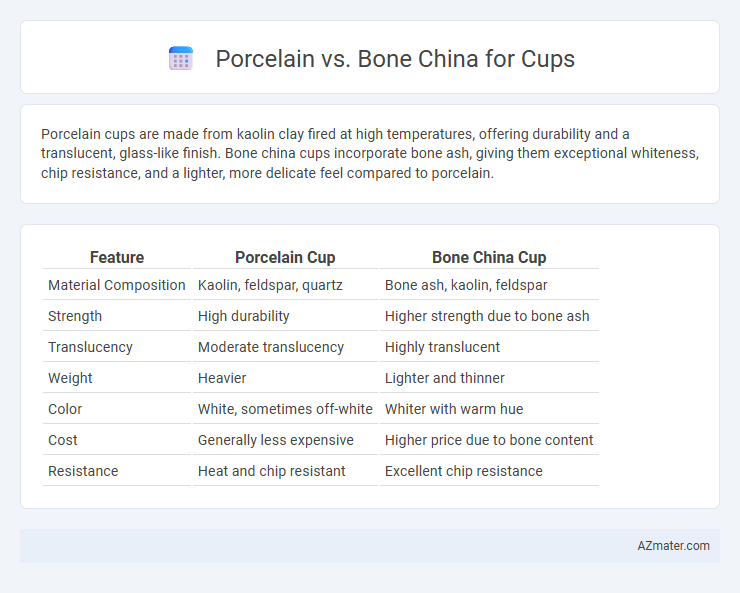Porcelain cups are made from kaolin clay fired at high temperatures, offering durability and a translucent, glass-like finish. Bone china cups incorporate bone ash, giving them exceptional whiteness, chip resistance, and a lighter, more delicate feel compared to porcelain.
Table of Comparison
| Feature | Porcelain Cup | Bone China Cup |
|---|---|---|
| Material Composition | Kaolin, feldspar, quartz | Bone ash, kaolin, feldspar |
| Strength | High durability | Higher strength due to bone ash |
| Translucency | Moderate translucency | Highly translucent |
| Weight | Heavier | Lighter and thinner |
| Color | White, sometimes off-white | Whiter with warm hue |
| Cost | Generally less expensive | Higher price due to bone content |
| Resistance | Heat and chip resistant | Excellent chip resistance |
Introduction to Porcelain and Bone China Cups
Porcelain cups are crafted from a mix of kaolin clay fired at high temperatures, resulting in a durable, non-porous surface with a smooth, glossy finish ideal for everyday use. Bone china cups incorporate bone ash in the clay blend, offering enhanced whiteness, translucency, and a lighter yet stronger structure compared to traditional porcelain. Both types provide excellent heat retention and a refined aesthetic, but bone china cups are often favored for their delicate appearance and superior strength.
Composition and Material Differences
Porcelain cups are made primarily from kaolin clay, feldspar, and quartz, resulting in a dense, durable, and non-porous material with a white, translucent finish. Bone china incorporates bone ash (typically 30-45%), kaolin, and feldspar, giving it superior strength, a warmer, slightly translucent appearance, and a lighter weight compared to traditional porcelain. The higher bone ash content in bone china enhances translucency and chip resistance, distinguishing it from the more brittle and opaque porcelain.
Manufacturing Processes Compared
Porcelain cups are made using a mixture of kaolin, feldspar, and quartz, fired at high temperatures between 1,200degC and 1,400degC, which produces a dense, vitrified body with a translucent quality. Bone china incorporates bone ash into the clay mixture, typically around 30-45%, resulting in a lighter, stronger cup with a warmer, slightly ivory hue, fired at slightly lower temperatures between 1,100degC and 1,250degC. The inclusion of bone ash enhances mechanical strength and chip resistance, making bone china prized for its delicacy, translucency, and durability compared to traditional porcelain.
Durability and Strength
Bone china cups are known for their superior durability and strength due to the high content of bone ash, which makes them more resistant to chipping and cracking compared to traditional porcelain cups. Porcelain cups, while sturdy, tend to be more brittle and prone to damage under impact or thermal stress. The increased resilience of bone china ensures longer-lasting use, especially in everyday settings where durability is essential.
Weight and Thickness
Porcelain cups are typically thinner and lighter, offering a delicate and translucent appearance due to their refined clay and higher firing temperature. Bone china cups, infused with bone ash, are generally slightly thicker but remain lightweight, combining durability with a smoother, creamier texture. The weight difference is subtle, with bone china providing a sturdier feel while maintaining elegance in thickness compared to porcelain's more fragile structure.
Appearance: Color and Translucency
Porcelain cups exhibit a bright white color with a smooth, glossy finish and moderate translucency, allowing light to pass softly through the thin edges. Bone china cups, prized for their creamy, ivory-white hue, boast higher translucency due to the bone ash content, creating a delicate and almost translucent appearance under light. The subtle differences in color and translucency between porcelain and bone china enhance the aesthetic appeal and perceived elegance of each cup type.
Heat Retention and Usability
Bone china cups excel in heat retention due to their denser composition and fine bone ash content, keeping beverages warmer longer than porcelain. Porcelain cups, while slightly less effective in heat retention, offer greater durability and resistance to chipping, enhancing usability for everyday use. Both materials are dishwasher safe and suitable for microwave use, but bone china's lightweight and translucent quality provide an elegant drinking experience preferred in high-end settings.
Price and Value Considerations
Porcelain cups generally offer a more affordable price point compared to bone china, making them a practical choice for everyday use. Bone china, known for its higher translucency and durability, often commands a premium price, reflecting its luxurious quality and craftsmanship. Consumers valuing long-term elegance and strength may find bone china provides greater value despite the higher initial cost.
Suitability for Everyday Use or Special Occasions
Porcelain cups are highly durable and resistant to chipping, making them ideal for everyday use due to their strength and ease of maintenance. Bone china cups offer a delicate, translucent quality with superior whiteness and lightness, best suited for special occasions where elegance and fine presentation are priorities. Both materials provide excellent heat retention, but porcelain's robustness favors frequent use, while bone china's refined aesthetic enhances formal settings.
Which Cup Should You Choose?
Porcelain cups are known for their durability, resistance to chipping, and affordability, making them ideal for everyday use. Bone china cups, composed of bone ash, offer exceptional translucency, lightweight feel, and a delicate, refined appearance favored for special occasions. Choosing between porcelain and bone china cups depends on whether you prioritize strength and cost-efficiency or elegance and a sophisticated drinking experience.

Infographic: Porcelain vs Bone china for Cup
 azmater.com
azmater.com